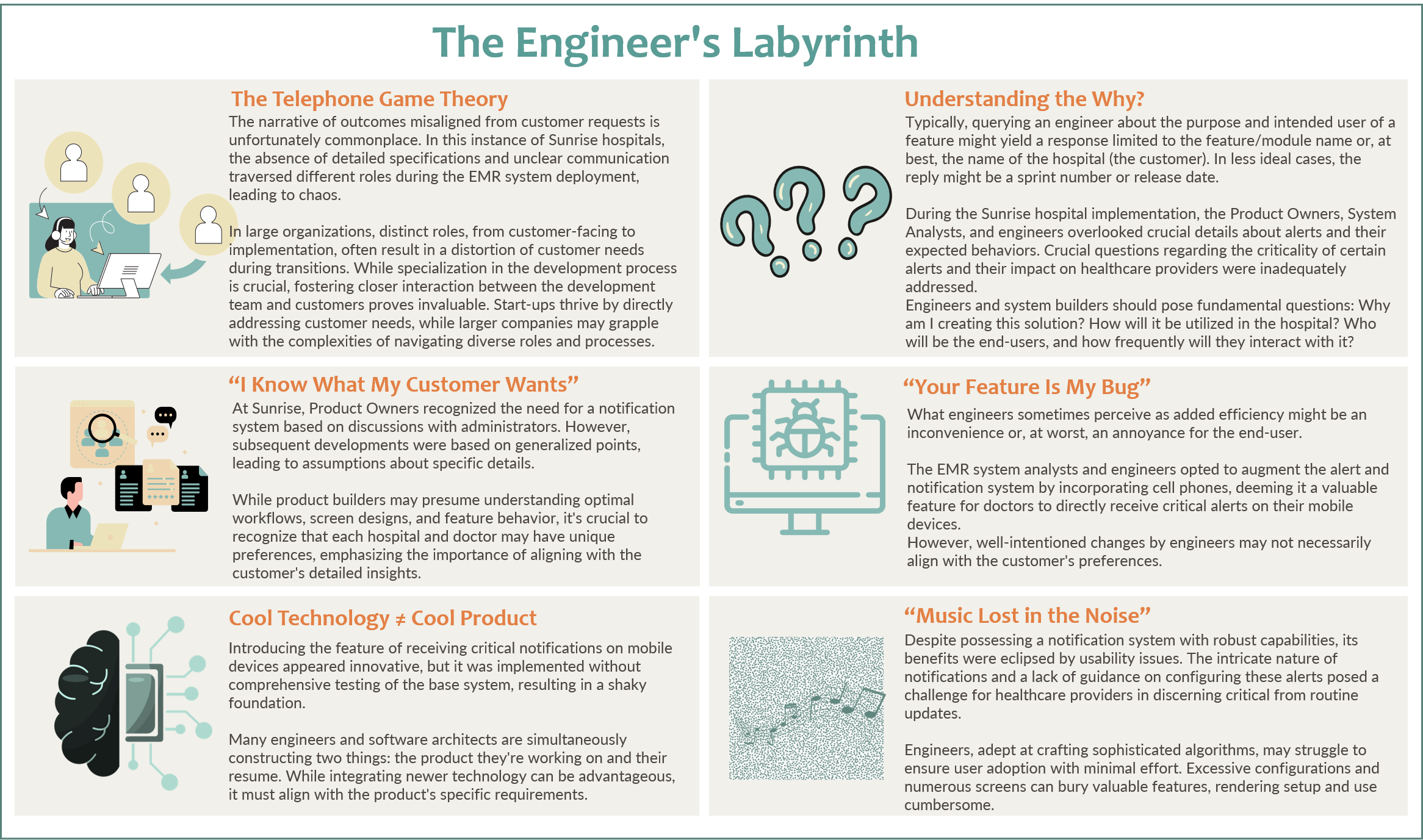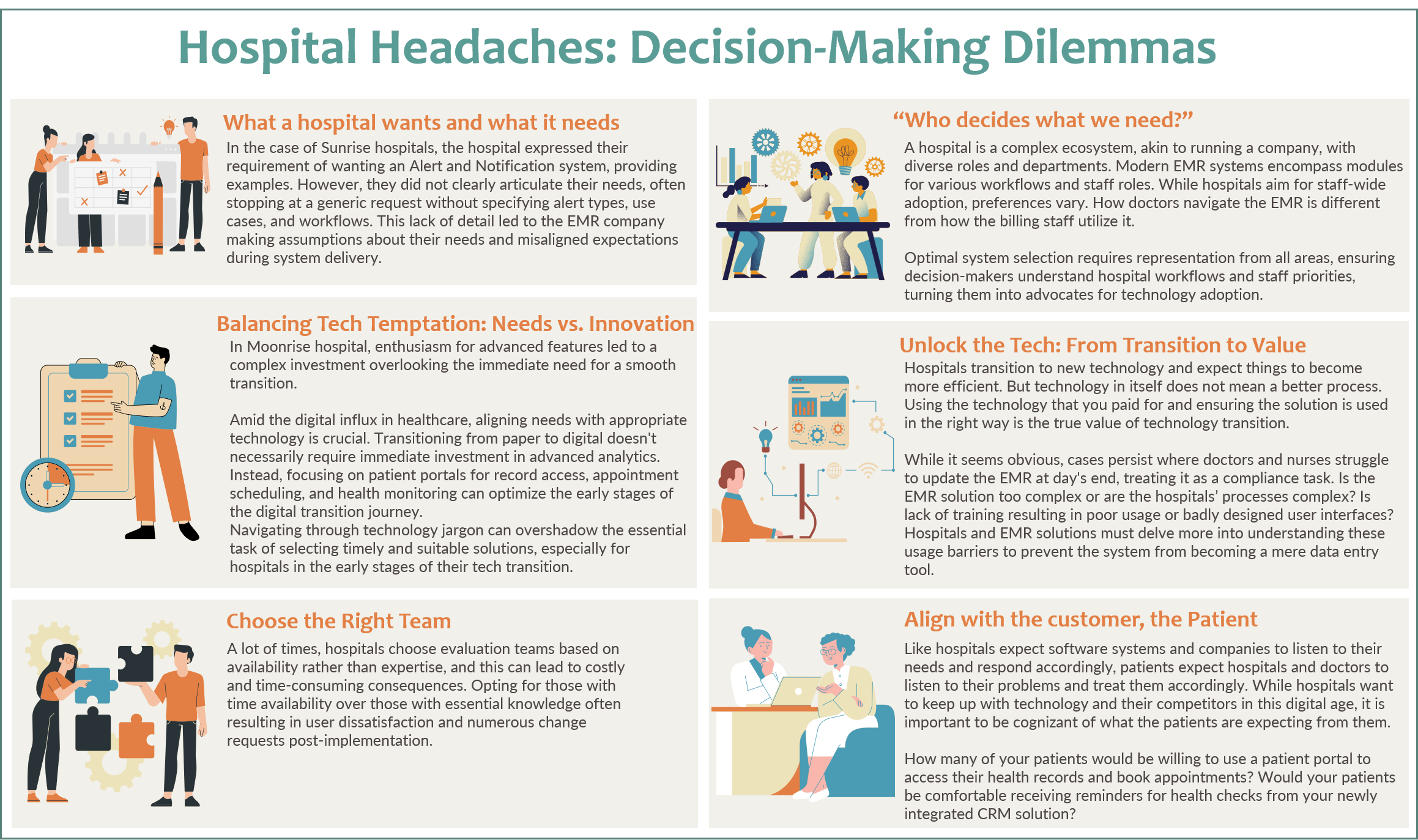Over the last decade, I've worked in various healthcare IT roles, with a particular emphasis on developing and implementing EMR systems for hospitals. Recently, I've transitioned to collaborating with hospitals for the evaluation and implemention of these systems, and I've also experienced them as a patient.
This situation is common, especially in dealing with challenges in using EMR systems in the healthcare world:
Hospital staff express frustration with system behaviours not meeting expectations.
EMR support engineers tackle issues with incomplete information that the hospital's IT team could have managed.
EMR support managers feel stressed about delayed issue resolution and SLA concerns.
Hospital management are annoyed by workflow disruptions and resource losses caused by the new system, considering the initial promise of increased efficiency.
Ultimately, patients may face delays in treatment, difficulties reaching healthcare providers, and potential treatment errors due to inaccurate EMR records.
Why do these scenarios occur?
In my experience, individuals typically aim for excellence in their roles:
Doctors strive for effective treatment and a swift recovery for patients.
Engineers work towards providing solutions that meet all requested requirements.
Project managers aim to deliver projects promptly while safeguarding their teams and companies.
Nevertheless, each role operates within unique constraints, experiences, and understandings, sometimes influenced by preconceived notions, leading to various scenarios.
The perspective used to evaluate a situation can significantly influence how we define solutions and resolve issues. Having navigated through these roles, I have tried to bring out my observations from each of these perspectives that could be contributing to scenarios like the one we saw at ACare hospital. While I write it primarily from the EMR system experience, these easily apply to other healthcare systems too.

Part I: The Engineer’s Perspective - Crafting Solutions
Software engineers’ endeavour to shape the world through their code, yet the complexity of vast systems often obscures their view from an external perspective.
While conscious of customer needs, they become engrossed in optimizing services, perfecting algorithms, and refining user interfaces. Amid these technical pursuits, the challenges of navigating regulatory requirements, scrum meetings, and project-specific tasks may divert their attention, potentially causing them to lose sight of the fundamental customer needs.
Sunrise Healthcare System recently adopted a new EMR system with a focus on implementing a robust notification system for critical updates in patient records. During planning, hospital administrators outlined their expectations, sharing examples of desired notifications. While EMR System Analysts acknowledged these needs, the system went live with a flood of notifications, causing confusion among healthcare providers who struggled to distinguish urgent alerts from routine updates.
Neither the hospital nor the EMR team had gone into the details of the types of updates or the urgency levels that would trigger alerts. The developers, lacking explicit details about the different types of alerts, looked at the System Analysts notes from the hospital and made assumptions about what they deemed as critical updates. The lack of specificity in the initial requirements led to a disconnect between the hospital's expectations and the delivered solution.
A Shift in Perspective
Engineers should pivot their focus from explaining their solution to comprehending what hospitals anticipate from the software and how they plan to utilize it. It transcends technology; it's about fulfilling the requirements of doctors, nurses, hospital staff, and patients. Rather than being overly immersed in OUR solution, the intricacies of OUR product's behaviour, and detailing how WE designed the process, a subtle shift in perspective is needed—considering what the hospital expects from the software and how THEY intend to use it.
Part II: The Manager's Role - Bridging the Gap
Stepping into a managerial role provided me with the opportunity to collaborate with implementation specialists and hospitals, tailoring and deploying EMR systems to seamlessly integrate technology with healthcare practices. While the insights shared here are pertinent to managers, their applicability extends beyond managerial roles to encompass the broader realm of EMR systems and companies.
Moonrise Healthcare System transitioned from paper records to "AOne EMR Solutions" based on an impressive sales pitch, featuring predictive analytics, complex decision support systems, and extensive customization. Eager to adopt cutting-edge technology, Moonrise purchased a comprehensive package without assessing their immediate needs. The promised swift implementation, however, clashed with the practicalities of customizing the system to fit the hospital's unique workflows. In the rush, comprehensive user training was overlooked. The hospital staff received only basic training sessions that did not adequately prepare them for the complexities of the new system.
A Shift in Perspective
EMR companies and system managers must shift focus from internal intricacies and feature sets to a holistic understanding of the healthcare ecosystem. This involves fostering collaboration between diverse health IT systems and tailoring solutions to meet the unique needs of each hospital. Only then, would it be possible to offer solutions that cater to the entire hospital ecosystem, moving beyond providing isolated point solutions.
Part III: The Hospital's Perspective- Weighing the Options
Transitioning into a consultant role for hospital IT solutions provided a comprehensive view of technology decision-making, including assessing workflows, feature sets, and weighing costs and benefits. This perspective revealed the financial and operational implications of technology choices, emphasizing the importance of considering long-term outcomes for the hospital and its patients.
This shift in perspective, from my previous role, has been enlightening. It offers insights into potential improvements in solution implementation and customer interactions, providing a deeper understanding of client requests that may have appeared unnecessary in the past.
Now, exploring the role of the hospital and its contribution to these circumstances, how do they shape and influence these dynamics?
A Shift in Perspective
Hospitals are often suspicious of EMR and IT solution companies, and patients are suspicious of hospitals. Both have the same concerns of the other - Are they giving me the best treatment/service? Are they charging me excessively? Are they charging me for things which are unnecessary for me? Are they keeping my data secure and not compromising my privacy?
Hospitals should shift their perspective from viewing EMR and health IT solutions solely as operational and efficiency improvement tools to recognizing them as crucial components in delivering patient-centred care. The focus should evolve from mere technological adoption to a patient-centric approach that integrates technology seamlessly into the overall healthcare experience.
Part IV: The Patient's Perspective - Experiencing Healthcare Firsthand
The most crucial phase of this journey is experiencing healthcare as a patient. Because as a patient you have just one objective - get healthy. No other incentives, no other targets.
All other things are enablers, frills and sometimes, even annoyances.
As a patient,
"I do not care if my doctor uses the most powerful Clinical notes feature integrated with voice commands, handwriting recognition and CDS support as long as I am diagnosed and treated correctly."
I'm not concerned about the hospital's EMR system's advanced billing features. I just want my bills to be accurate and transparent."
"I don't care if my doctor's EMR system has the latest appointment scheduling tools. I simply want to be seen promptly and receive updates about my appointment."
Hospital visits are inherently stressful. If the process of appointment booking and waiting exacerbates this stress, a solution is needed. Allowing patients to manage appointments, view reports, and make payments remotely can alleviate hospital-related stress. However, tailoring solutions to specific patient demographics is crucial for effective implementation.
Like engineers and EMR solution providers assume they know what their customers want, so do hospitals.
Do reminders on health checks and updates on offers help your patients or do they annoy them?
Would your constant messages and mails requesting feedback on service, improve your patient's experience or ruin it?
While I must bite my tongue as I say it - Conducting brainstorming sessions with patients might sometimes yield more ideas for hospitals than from solution providers.
But the fact that a lot of hospitals are investing in improving patient engagement and making information more accessible is a welcome step. The significance of well-designed patient portals, timely communication, and easy access to medical history is now more than ever. The frustrations of information silos and inefficiencies in patient engagement are evident.
Maintaining the human side of healthcare while bringing in technology to improve processes and providing a seamless, patient-centred experience is the key.
The Interconnectedness of Perspectives
This journey underscored the interconnectedness of perspectives.
The work of engineers and system builders significantly impacts the experiences of healthcare professionals and patients, while the manager's role facilitates collaboration and integration for clinical workflows. Hospital decisions directly shape patient care, and patient experiences underscore the need for patient-centered IT solutions.
This journey through healthcare IT emphasizes that every role plays a vital part in the quest for better care and outcomes. It's intriguing also how our perspective can shift based on our role, often leading us to focus solely on that perspective and view other roles with suspicion.
However, if we can shift our perspective towards the overall ecosystem, it can unveil constraints and solutions more efficiently. The interconnectedness of these perspectives is crucial to achieve the common goal of delivering better, more patient-centric healthcare, while acknowledging and addressing apprehensions and challenges along the way.
NOTE: All the graphics used are designed by the author, exclusively for this article using Canva elements. Kindly request permission and provide attribution to the author before utilizing them.









